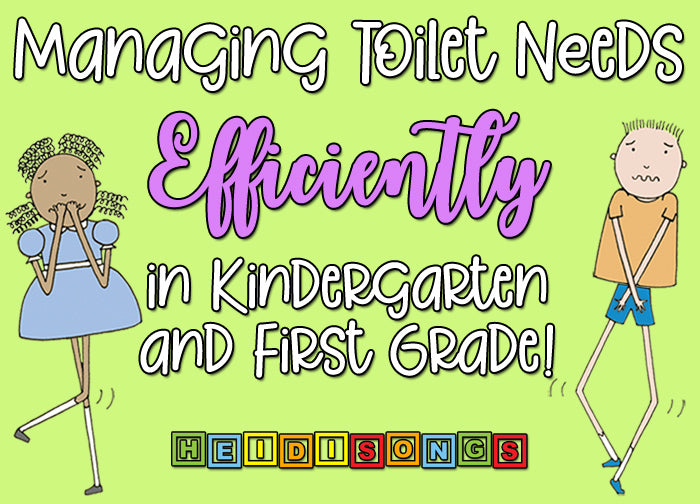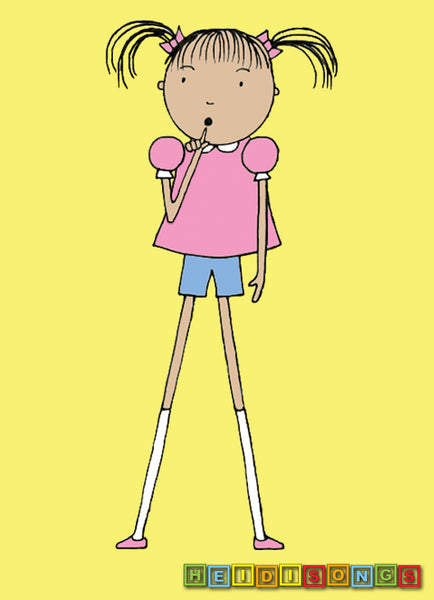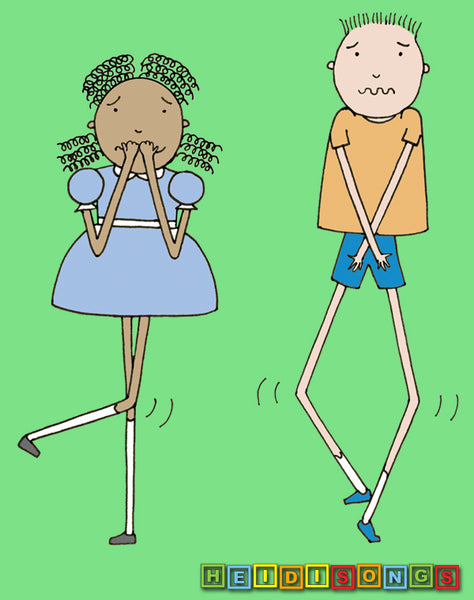
Managing the toilet, restroom, bathroom, or potty needs of young children in the kindergarten or first grade classroom can be a challenge! When one child asks to go and is given permission, several other children often ask to go as well. How can you manage toilet needs with a minimum of instructional time wasted, and without touching off a three ring circus in the restroom?

Obviously, when nature calls, we have to listen! But with a few good procedures in place, toilet needs can be managed efficiently in the classroom! Here are my rules and procedures for managing restroom needs so that my little ones can use the toilet with minimal lesson disruptions.
No Potty "Wannabees" or Buddies! Kids Go ALONE!
This means that if a child decides that he needs to use the restroom after seeing that someone else got permission, my answer is "no." Only YOU know if YOU need to use the toilet. You will not be given permission to go just because someone else gets to go. We don't go the restroom because we like to go with friends. We go because we need to use the toilet. And seeing a friend get permission to go doesn't mean that your body is telling you that need to use the toilet.

There is another reason for this as well: our restroom is shared with three other classrooms, (that is about 60 students) but there are only three toilets in it. If all three teachers send two or three children at a time to the restroom, there could be six to nine unsupervised children in there together, all waiting to use just three toilets. This could turn into a great, big "Potty Party" that could take a very long time, rather than a quick trip to use the toilet.
So unless my administrators tell us otherwise, the children go alone to the restroom. Exceptions? Occasionally I have a child that is truly nervous to go alone and I don't have my teammate nor a volunteer available that can go along. In that case, I choose a child to go along. I rarely ask for student volunteers.
I always tell my students this: What does one child in the restroom plus one child in restroom equal? When they reply, "Two," I always say, "Nope! TROUBLE!!!" LOL!
This is what my experience has taught me: If a child truly need to go, he/she will ask to go more than once, such as when the first child that went to the restroom returns.
What About Older Children?
When I taught second grade, I had a couple of children who had been fine using the restroom all year long, but had gotten in trouble using it together. I stopped allowing them to go together, and then suddenly one of them told me that the bathroom was "haunted" and she was afraid to go by herself. When I pointed out that she had been using it all year long by herself without a problem, she just cried and refused to go by herself. The crying/whinning continued off and on, all morning long.
My solution? I sent her to the nurse's office to use the restroom there. ;)
Ask Parents to Have Kids Use Toilet Right Before Drop Off- And then, JUST SAY NO (For a While)
During my first year of teaching TK (Transitional Kindergarten), my administrator made a policy that all students in the younger grades must go to the restroom with a buddy. (This was prompted by a safety related bathroom incident.) However well meaning, the new policy caused HUGE problems in my room, because suddenly the children found that they could ask to go to the restroom at any time- and a someone from the class would get to COME ALONG! It was like an INSTANT FIELD TRIP PARTY TO THE RESTROOM!!!!! They were suddenly able to stop any lesson, and the insistent claims of really needing to go RIGHT NOW were getting worse by the day!

So, on the following week's homework, I attached a note asking parents to please take their child to the restroom RIGHT BEFORE DROP-OFF, and to also let me know if their child would have a problem waiting 45 to 60 minutes to use the toilet after that. I told them that I was going to say "no" to all requests to use the restroom for the first 45-60 minutes of the day, unless they told me otherwise. (I also always watch for potty dancing, bottom squeezing, and looks of urgency on the faces of the children.) Then, when I picked up the kids, I quickly checked in with the parents by calling out, "Did everyone just use the toilet?" If anyone said no, then I had JUST THAT CHILD stop and use the restroom on the way in.
This solved MOST of my problems immediately, I'm happy to say! I did explain the change in routine to the children, but of course they didn't really understand until they saw it happen. When the first child happily raised his hand to use the restroom, I just reminded him that his mother told me that he just went right before he came, and that mom said she was sure he could wait. The disappointed child lowered his hand slowly in confusion.
The same thing happened a few minutes later. Each time, I reminded the class that we were going to use our time at home to go to the restroom, and spend our time at school learning instead. After a while, they got it!
Try a Secret Potty Signal
Although I have not used this method in TK yet, I used Secret Signals in Kindergarten every single year and I think they are FANTASTIC for classroom management! The basic idea is that if they want to use the restroom, they MUST ask by giving you the "secret signal," such as putting one finger up. (You can choose any signal you like, of course! That one was just mine.) I've seen other teacher use crossed fingers to represent crossed legs, and I like that one, too! LOL!

The advantage of a secret signal to indicate that a child needs to use the toilet is that the question, "May I use the restroom?" can be asked completely silently. All you have to do is make eye contact with the child an nod to give permission, or shake your head no. If the other children miss this exchange, then they probably will not even notice that someone else got to get up and go to the restroom! The whole thing happens seamlessly, without disrupting the lesson or causing any "Potty Wannabees!"
The only difficult thing about getting this system started is that you simply cannot give children permission to go to the bathroom unless they give the quiet signal. I have had a few difficulties with children that insist over and over that they are just going to raise their hand and ask in the traditional way. I always just say, "I'm sorry. I can't give you permission unless you ask me with the Silent Signal." It takes a while, but if I'm consistent with this, I can get my whole class to use the signal after about a month of school.

The amusing thing is that I have had adults observe my class and then ask why I allow children to get up and leave the room without permission at any time! That's when I say, "Oh, but that's not happening! Just because you didn't see me give permission doesn't mean that I didn't give it." Then I explain exactly what happened.
We have other secret signals, too!
1 finger up means: I need to use the toilet.
2 fingers up means: I want to get a drink.
3 fingers up means: I need a tissue.
4 fingers up means: I want to get or put away my jacket.
5 fingers up means: I have something to say that has NOTHING to do with the lesson whatsoever. ;) (Just kidding! LOL!)
Try Using Some Music to Teach Your Expectations!
Our Classroom Management Video Collection has some awesome songs on it for teaching rules in the restroom! My favorite is the Potty, Potty, Flush, Flush song because it is simple and straightforward! You can get it on DVD, CD, iTunes, or streaming on internet video on Vimeo!

Another good song on this collection is the Potty Dance Song! It always makes me wonder how little ones can be so unaware of their own needs when they are dancing around, doing the Potty Dance?

We don't have either of these videos posted on YouTube, but we do have this one as an example!
Solutions for "Curriculum Induced" Potty Needs
Have you ever noticed how RARE it is when a child wants to go to the restroom during playtime or recess? Who needs to go THEN, anyway? What could be LESS important at that point? But get out that phonemic awareness curriculum and see how many kids suddenly need to go!! HA!
So what is the answer to "Curriculum Induced Potty Needs?" I always say, "If you were fine during playtime, you'll be fine for this ten minute lesson." Another solution is to do those - um- "less popular, but necessary" lessons right before things like playtime or recess. And just tell them that you will let them go when the lesson is done, during playtime.

Note: it may be necessary to remind those kids during their playtime that they asked to go, and then insist that they DO go. Otherwise, they may ask right at the beginning of the very next lesson, and then what? At that point, they've been waiting a LOOOOOONG time! Very young children may never remember to stop playing to go to the restroom when surrounded by their friends and toys, so you may have to insist in order to avoid accidents followed by parent complaints, etc. So as you release your kids to recess, walk those children straight over to the restroom and make sure they use it.
How do you manage toilet needs in your classroom? Got any great ideas or tips to share? Please let us know in the comments below! Thanks!

----------------------------------
Follow me! Did you enjoy this post? Do me a favor and share it with your friends! And follow this blog by signing up for my email updates, or follow on Bloglovin', or follow me on TPT! I'm also on Pinterest, Facebook, Twitter, Instagram, Google+ and YouTube, too! Don't forget to sign up for our email newsletter (at the bottom of this page) for special deals and promo codes that you won't find out about anywhere else.

















